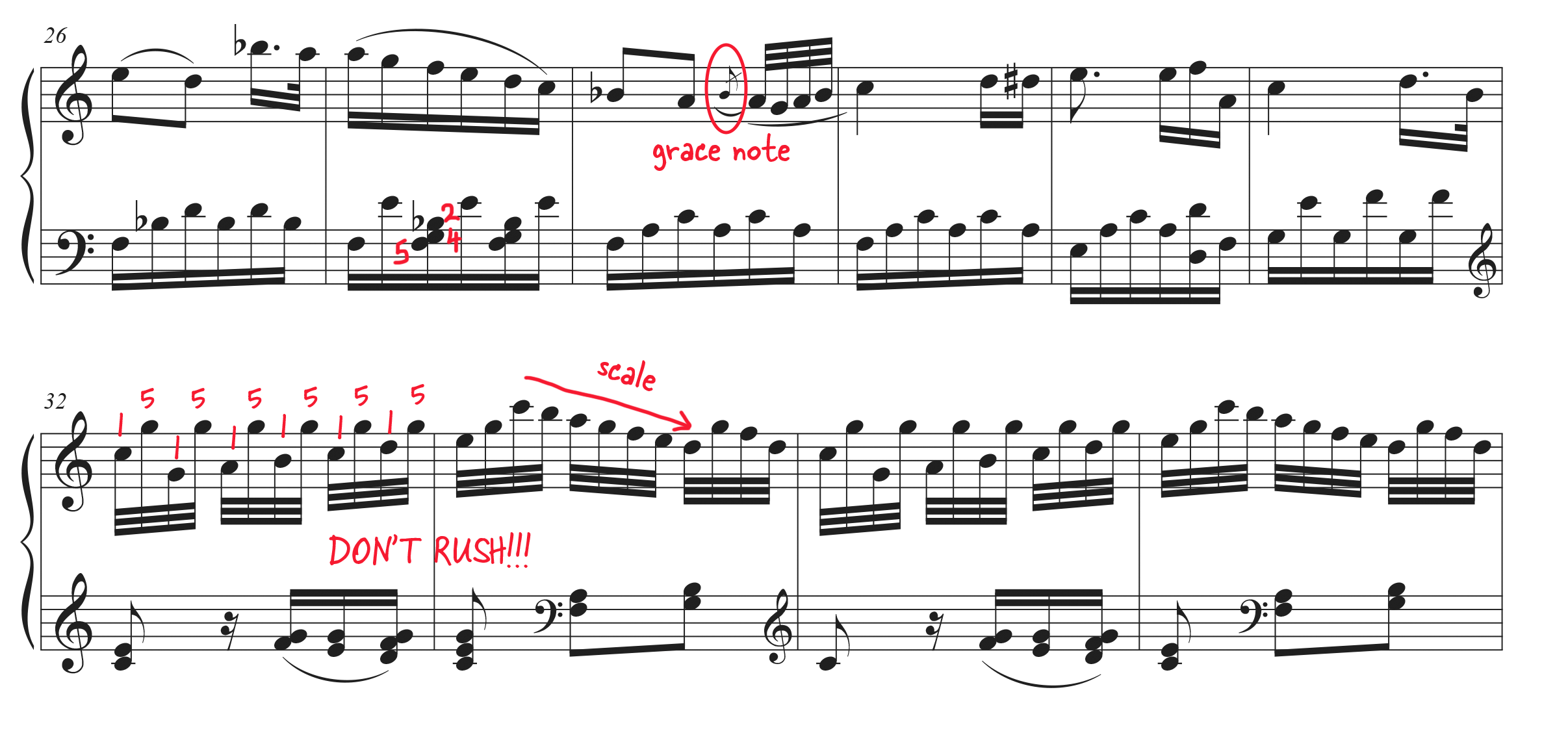“Für Elise” is one of the most famous piano pieces of all time. It’s a rite of passage for many aspiring piano players, it’s iconic, and it’s just difficult enough be a fun challenge without being too hard.
We’re SUPER excited to bring you this tutorial on how to play “Für Elise,” step-by-step, from start to finish. That’s right! We’ll cover everything in the song. This is likely THE most thorough “Für Elise” tutorial on the internet!
We’ll also share some facts about the history of this famous piece. After all…who was Elise?!
If you’re a Pianote Member, you can use our Practice-Along feature to play along, note by note. Not a Member yet? Try a 7-day free trial. You might even learn “Für Elise” in seven days!
Oh, and don’t forget to download the free piano sheet music:
“Für Elise” means “for Elise,” but who was Elise? Historians aren’t certain, but there are three main contenders: Therese Malfatti, Elizabeth Röckel, and Juliane Katherine Elisabet “Elise” Barensfeld.
Therese Malfatti is the most likely suspect because the original manuscript was discovered in her personal belongings. There’s even a story that Beethoven meant to write “für Therese” on the manuscript but was too drunk and his handwriting got interpreted as “für Elise” instead. The time of the composition is also around the time Beethoven may have proposed to Therese (only to be denied her hand in marriage).

Other possible Elises are Elizabeth Röckel—a soprano in Beethoven’s opera who also refused to marry him—and Elise Barensfield, a piano student of Therese Malfatti’s. Some historians believe Beethoven may have composed this piece for her as a favor to Therese.
Learn how to play “Für Elise” quickly and easily with our Practice-Along feature. Then, check out our song library and Method to get even more awesome on the piano!
TRY PIANOTE FOR 7 DAYS – FREEThis piece is in ABACA or rondo form. The A section is when you hear the iconic, two-note theme.
I’ll walk you through all the notes in the video, but don’t get overwhelmed by the fingering! You don’t have to finger notes exactly the way I do, and you’ll see that I sometimes switch fingerings around. Just use a fingering that you’re comfortable with!

What takes this piece from good to great are the dynamics and expression you choose to play it with. Get dramatic! Be flirtatious! (After all, this may have been a love letter of Beethoven’s!) Some words to know:
“Für Elise” wasn’t published until 1867, 40 years after Beethoven’s death. The lost manuscript was discovered by musicologist Ludwig Nohl, who declared it “not exactly important.”
Source: Sound Field

Things get interesting here…
This section may be a little more challenging for many of us because it’s less familiar to our ears. The mood also changes. We move into a “major” sound and things feel lighter and sweeter.
I suggest practicing the left hand first because the left hand serves as a sort of “foundation” to build your right hand on.

Important! Just because things get a little faster here doesn’t mean it has to be louder! It can be tempting to play loud and fast, but remember: this section is intended to be sweet and delicate. Save room (and energy!) for the song to grow louder and more dramatic later.
There are some different note values here, including some fast 32nd notes. Use your left hand (which you should learn first!) to align the notes of your right hand. Don’t rush those 32nd notes—it’s tempting, but it’s important to stay steady and accurate.
“Für Elise” is also known as Bagatelle No. 25 in A Minor, WoO 59. A bagatelle is a short musical piece meant for light entertainment. “WoO” means “without opus.” This is a system of organizing Beethoven’s works that don’t have opus numbers.
Source: Wondrium
Beethoven gets a little cranky here, I think. We change moods very dramatically.
There are some big cranky chords here…which can be intimidating to read. But tease them apart, and you’ll find that they’re simply variations on familiar chord shapes. For example, snowman-shaped chords are just regular triads in root position.

On your left hand, you’ll play some repeated notes and chords—the source of all the drama! And instead of playing all those repeated single notes with the same finger, you’ll notice that I switch between fingers 2 and 3. I think this helps me vary the feeling between the notes so they sound less monotonous.
The next bit is very beautiful and impressive. So make sure you practice it!

This is where your piano technique comes in. You’ll notice that the shapes and skills we use are the chords and arpeggios we practice all the time!
Did you know?
Garbage trucks in Taiwan play “Für Elise” when they get to a neighborhood, reminding residents it’s time to take out the trash!
And those are all the sections of “Für Elise”!
No two people play “Für Elise” the same. There is so much room for your own interpretation of the piece. To get inspired, check out these different performances:
Victoria Theodore
Victoria Theodore is our classical piano Coach! Here she plays Beethoven’s piece with a deft and precise hand. Her version is a little speedier, but her A minor arpeggio and chromatic scale section is a little livelier. Notice how she detailed she is in teasing out all those dynamics!
Lang Lang
World-renowned pianist Lang Lang is known for his on-stage theatrics. His interpretation of the B section is a little faster and livelier than mine or Victoria’s performance. Meanwhile, the arpeggio and chromatic scale section is more toned down.
Seymour Bernstein
Seymour Bernstein believes “Für Elise” isn’t taken seriously enough by most piano players. He believes the piece should “fire your imagination.” After all, we don’t know how Beethoven intended the piece to be played, we only have a few markings. Piano players should fill in the rest!
Lisa Witt has been teaching piano for more than 20 years and in that time has helped hundreds of students learn to play the songs they love. Lisa received classical piano training through the Royal Conservatory of Music, but she has since embraced popular music and playing by ear in order to accompany herself and others. Learn more about Lisa.


By signing up you’ll also receive our ongoing free lessons and special offers. Don’t worry, we value your privacy and you can unsubscribe at any time.
We use cookies for traffic data and advertising. Cookie Policy »